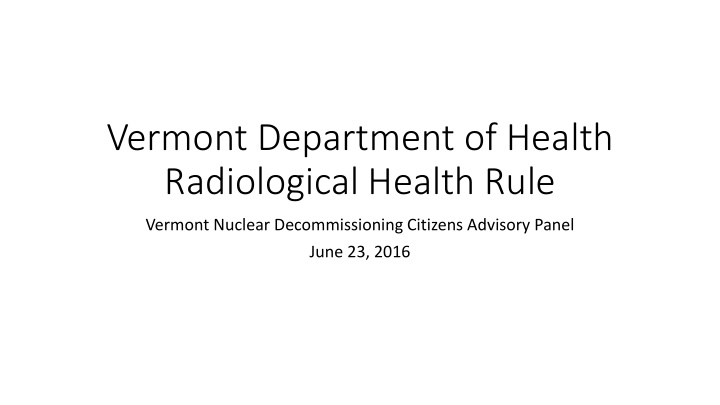



Vermont Department of Health Radiological Health Rule Vermont Nuclear Decommissioning Citizens Advisory Panel June 23, 2016
General Overview* • The most current revision was approved and made effective on January 1, 2010. • Its applies to “all persons who receive, possess, use or transfer sources of ionizing radiation” in Vermont. • It provides standards for protection of workers and the public; requires registration of sources; describes transportation notice requirements; and the rights of the Department relative to these regulated entities. • It exempts materials licensed by the U.S. NRC, but has specific “criteria applicable to Vermont Yankee Nuclear Power Station relating to members of the public”. *Sections 5-301, 5-302 and 5-304
Criteria Applicable to VYNPS Relating to Members of the Public* • Maximum permissible doses in unrestricted areas: • Must be kept as low as reasonably achievable; • Controls on discharges and direct gamma radiation: • Gaseous effluents cannot lead to doses in excess of 5 millirem per year; • Liquid effluents cannot lead to doses in excess of 5 millirem per year; • Radioiodine emissions cannot lead to doses in excess of 5 millirem per year; • Doses from radioactive particulates in air cannot exceed 5 millirem per year; • Direct gamma radiation emanations cannot exceed exposure rates of 20 milliroentgen per year above background (held to be equivalent to 5 millirem dose per year). *Section 5-305(D)(1)
Determination of Compliance to these Criteria* • VYNPS submits monthly reports to Health addressing each of the dose criteria by 15 th of following month. • VYNPS also submits an annual report for all discharges and direct gamma radiation by May 15 of following year. • VYNPS provides any other information requested relating to compliance. • Health conducts environmental surveys, sampling and other measurements to independently determine compliance, verifying the submittals above. *Section 5-305(D)(2)
Rights of the Department of Health* • To be provided copies of all reports furnished to the NRC related to effluent discharges. • To inspect and evaluate sources of radiation, premises where sources are used or stored, and pertinent data, records and reports. • To be notified of radiological incidents in the same manner as provided the NRC. • To obtain samples of environmental media for purposes of data correlation. • To enforce and take corrective actions to ensure compliance to the regulations. *Section 5-306 and 5-307
Opportunity for Questions and Contact • Contact: William.Irwin@Vermont.gov
Recommend
More recommend